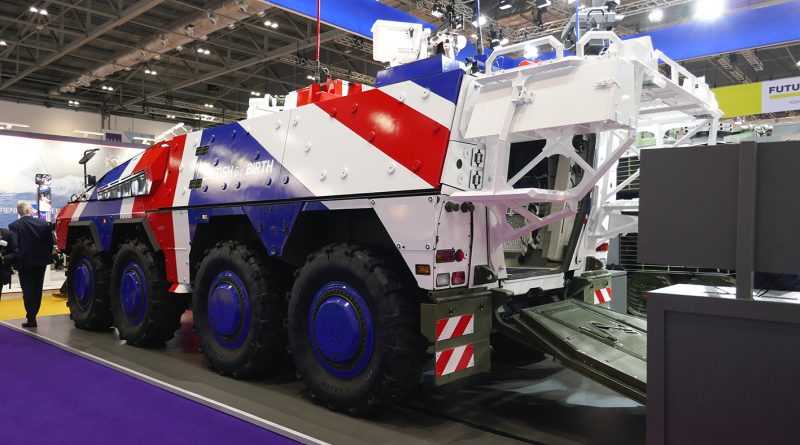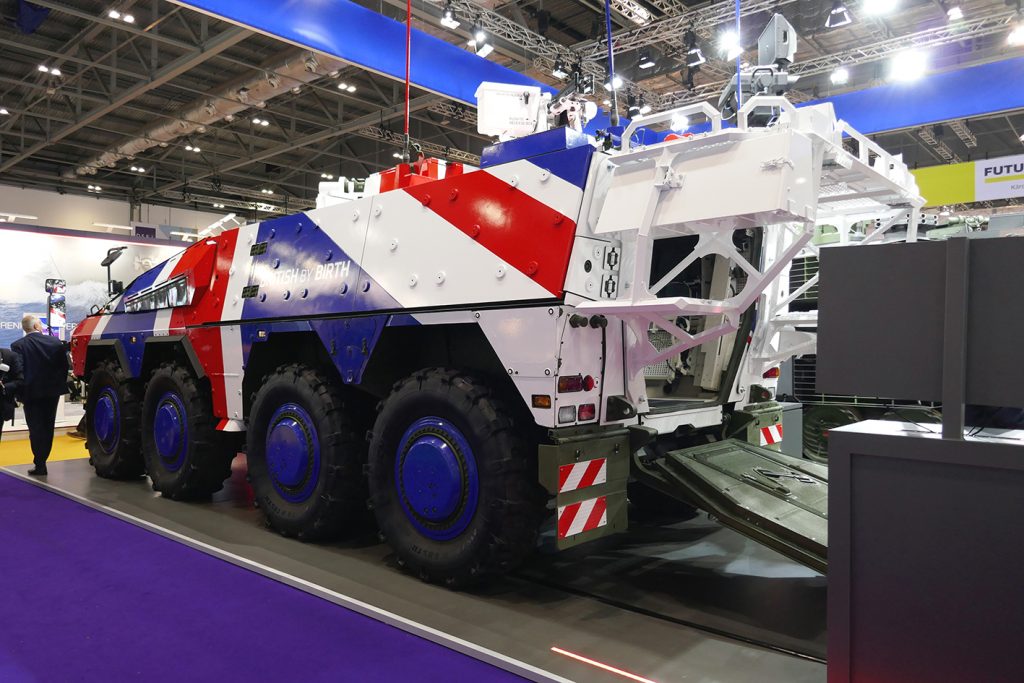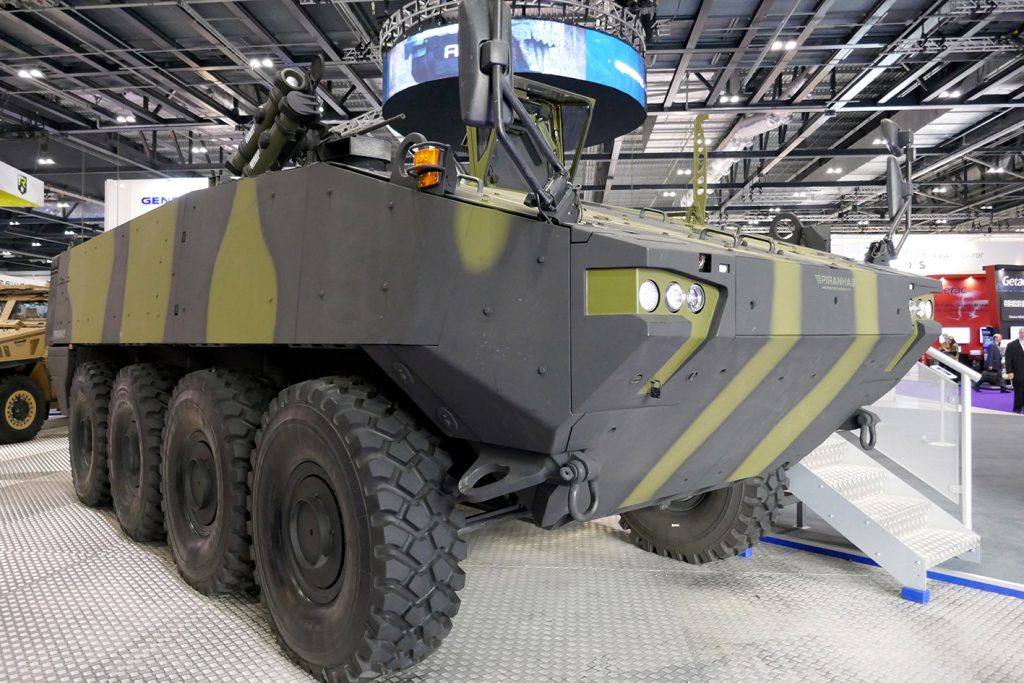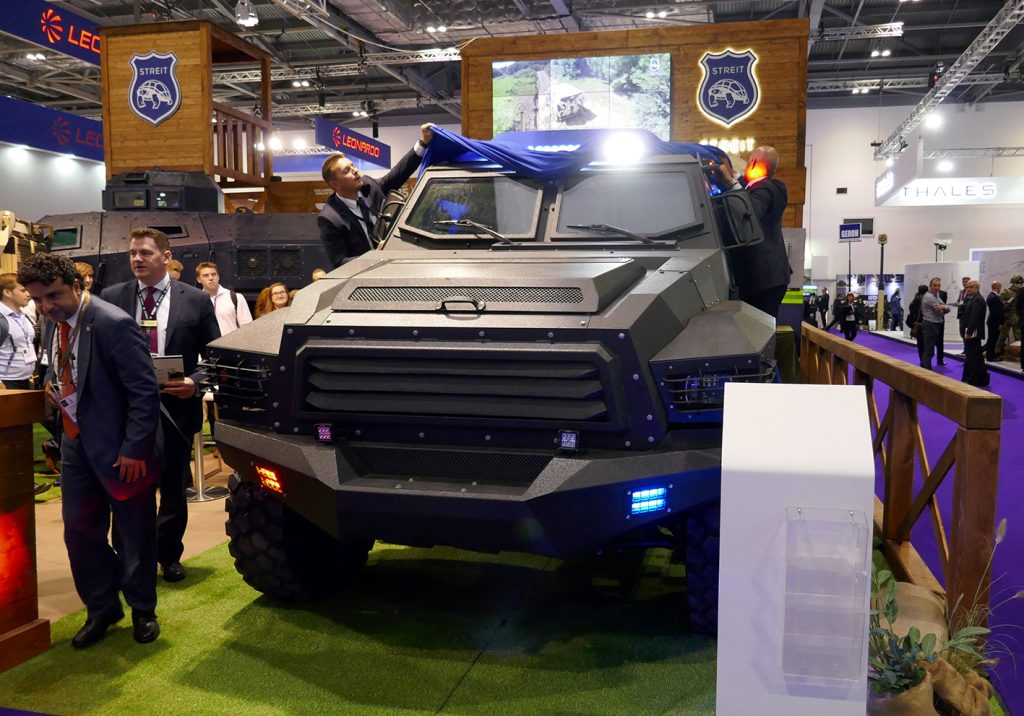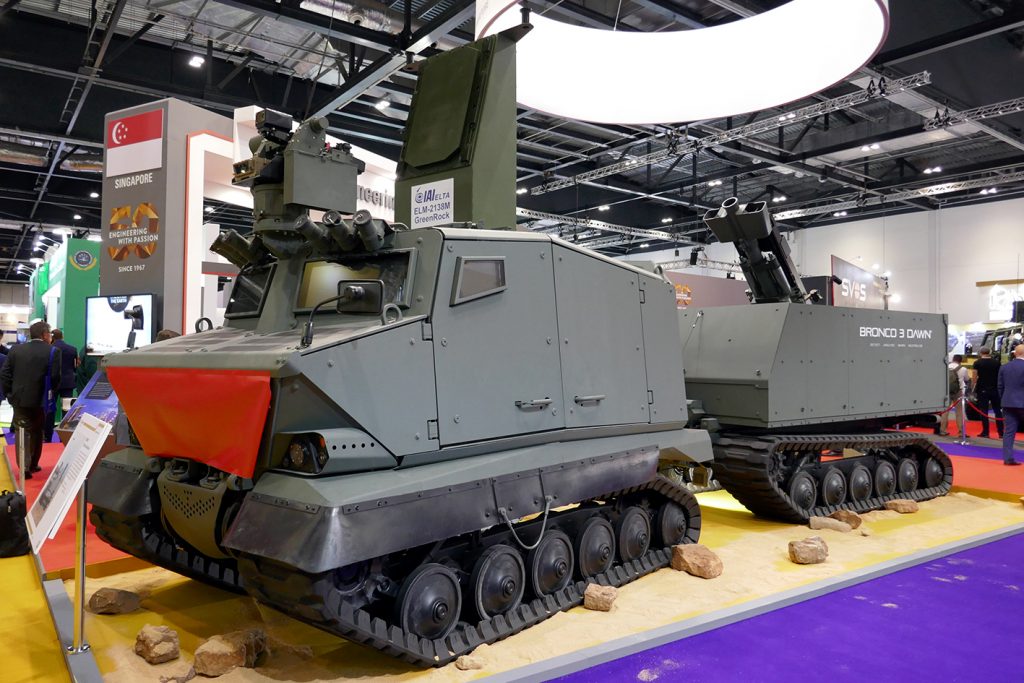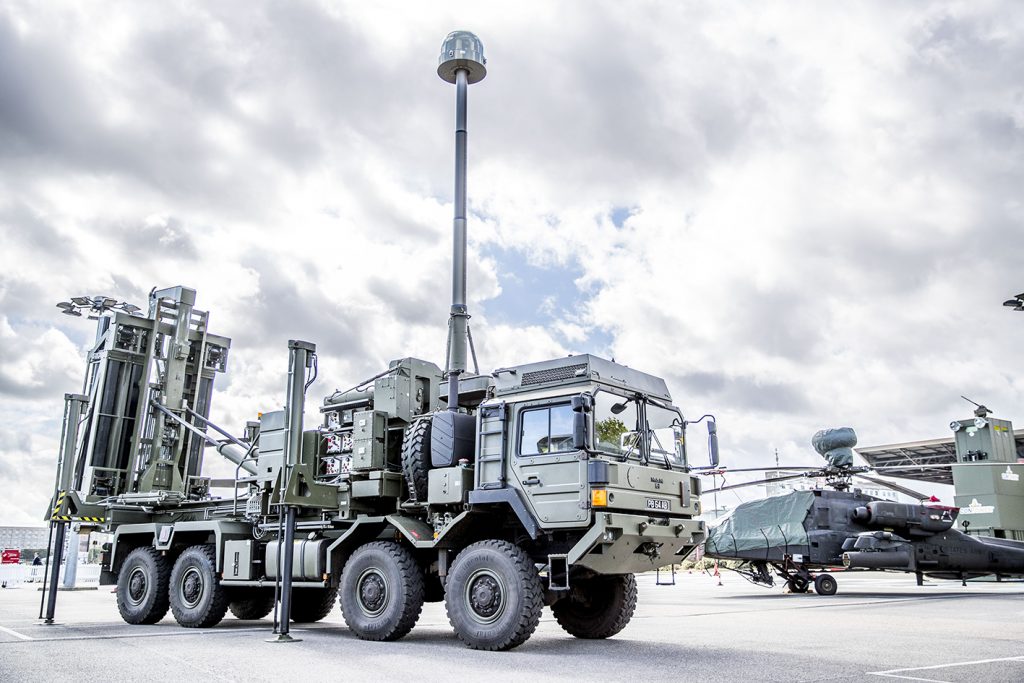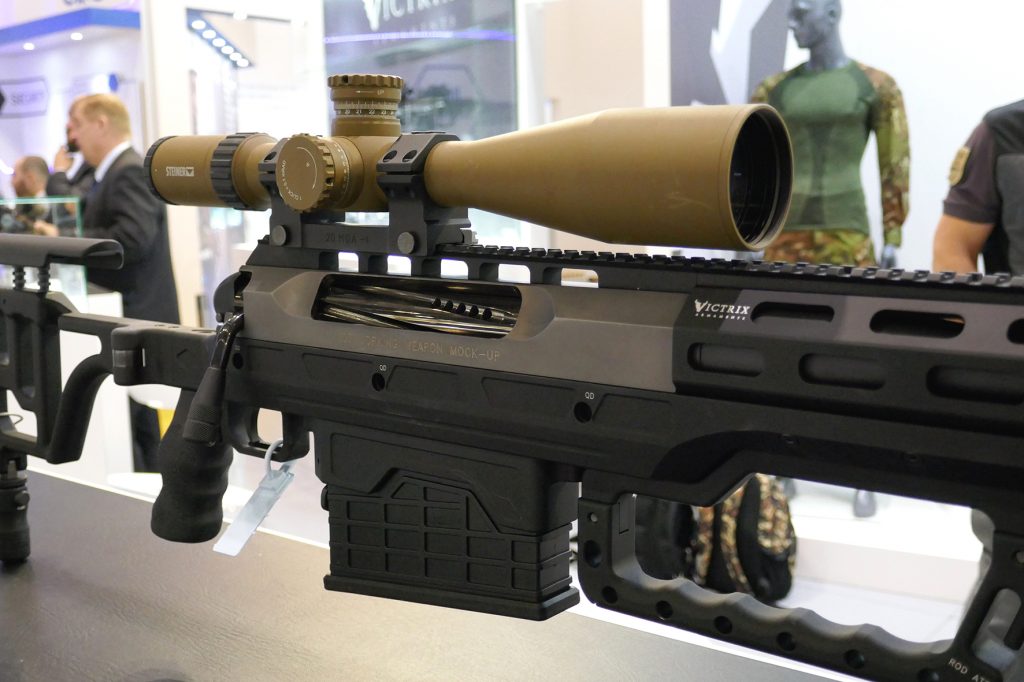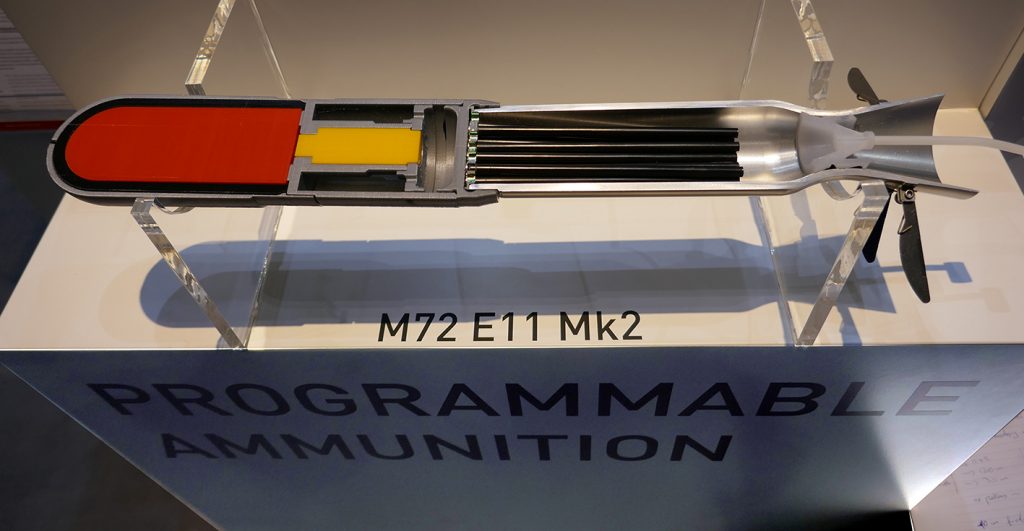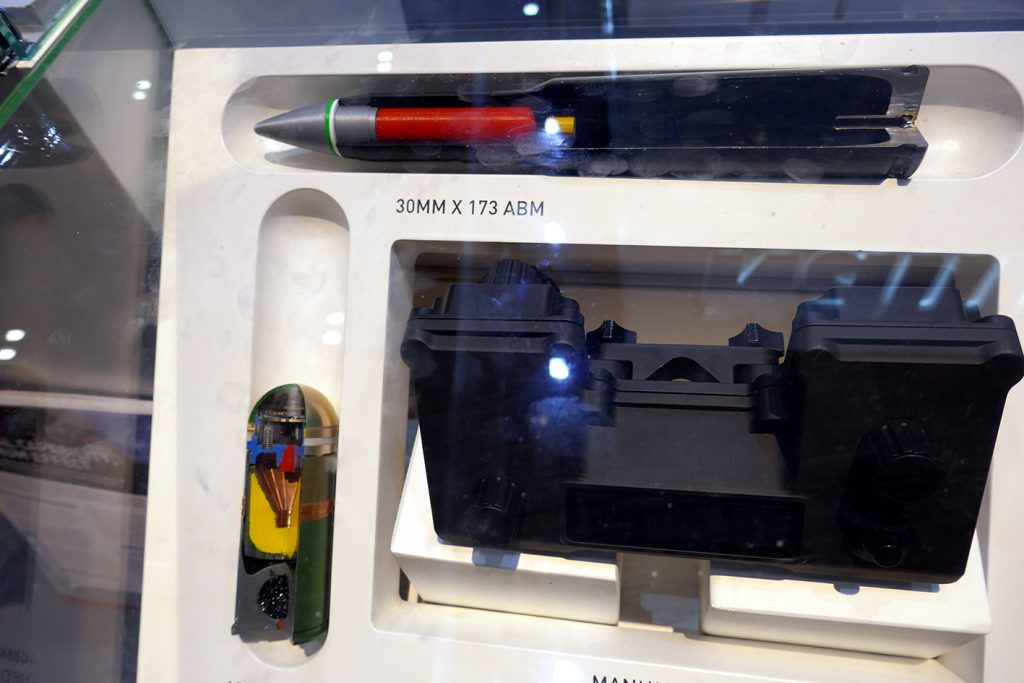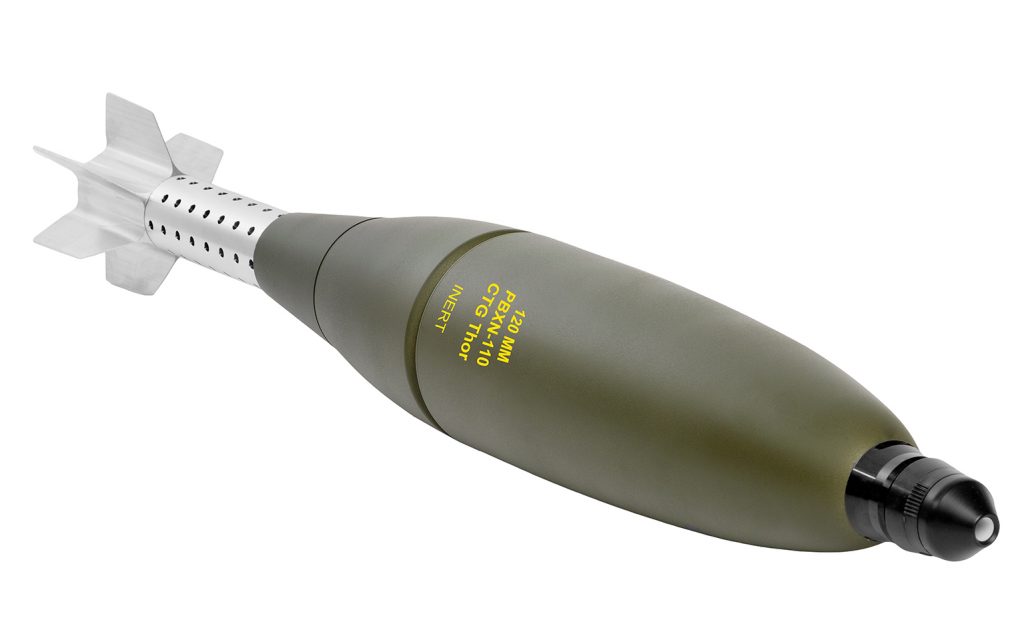Companies line up for the UK MIV Programme
by P. Valpolini
With a decision pending on the acquisition of several hundred vehicles the main subject in the land field at DSEI 2017 could be just one: the MIV or Mechanised Infantry Vehicle, the 8×8 system that should be deployed within the British Army new Strike Brigades. As explained by Brig. Zac Stenning, Commander 1st Armoured Infantry Brigade, the first unit to be transformed into a Strike Brigade, 1st Strike Brigade should start being formed in 2020, following two years of experimentation, the Army aiming at having its two brigades operational by 2025 to become part of the Joint Force. The first new vehicle to join the new formations will be the Ajax, based on a variant of GDELS ASCOD tracked IFV fitted with a Lockheed Martin UK two-man turret armed with the CTAI 40 mm gun employing case telescoped ammunition. The Household Cavalry Regiment, which at the time of DSEI was testing combined arms and new Strike concepts at the BATUS (British Army Training Unit Suffield) in Canada, will be the first unit to receive the new tracked vehicle, the first two having been presented to Government Acceptance Testing on Monday 18 September 2017. For the time being, surrogate vehicles are being used, also to simulate the MIV for which a decision is forecasted by year end, as stated by Maj. Gen. Chris Tickell, Director Capability, who also said that the service expects the 1st Strike Brigade to reach its initial operational capability by 2023. All contenders for the MIV contract, ARTEC Boxer, GDELS Piranha 5, Nexter VCBI and Patria AMV, were present at the ExCeL exhibition centre, all having gone through thorough testing by the British Army in previous attempts to buy similar vehicles under different programme names. Time is short, and it is unlikely that selection will follow the usual path. KMW and Rheinmetall played the “British by Birth” card, the UK has been part in the early days of the Boxer consortium, which it left in 2004. Having the UK back in the consortium is thus an option, the other being the same of the other competitors, that is ensuring a high workshare to UK companies.
At the Rheinmetall stand the Boxer was painted with the Union Jack, definitely a unique camouflage! (P. Valpolini)
The Piranha 5 is General Dynamics Land Systems contender for the MIV programme. (P. Valpolini)
Streit adds a Gepard to its portfolio
On Day 1 of the exhibition, the Streit Group launched its Gepard armoured security vehicle, which in the military role is offered for convoy escort, EOD team transport, or ambulance. A modular vehicle, this 7.6 tons vehicle can carry a 1.5 tons payload and is powered by a 6.7L Power Stroke V8 turbodiesel by Ford providing 381 hp. A petrol option is also available, the transmission being a six-speed automatic with selectable four-wheel drive configuration. The two-man crew and six dismounts are protected by a Level BR6/BR7 armour. A rear flatbed allows carrying supplies or equipment, such as a vehicle-borne assault system for special operations. The Gepard can be fitted with an RCWS armed up to 12.7 mm machine gun or 40 mm automatic grenade launcher.
The unveiling of the new security vehicle developed by the Streit Group, the Gepard. (P. Valpolini)
A new Bronco from Singapore
ST Kinetics from Singapore unveiled the latest iteration of its Bronco all terrain tracked carrier. The new Bronco 3 leverages the experience acquired by the company with its Bronco 1 and its Bronco 2, the latter better known as Warthog, the name used by the British Army which used it extensively in Afghanistan. The latter gave up part of its mobility to increase protection, thus the company decided to design a new vehicle to include higher protection while maintaining mobility; extra doors were added to improve maintainability, while fuel tanks have been moved outside in order to increase the usable space. The Bronco 3 curb weight is 10.2 tonnes, one ton less than the original Bronco 1 while having a much greater protection; this is due to the adoption of new materiel as well as to exploit some elements for dual use, i.e. some tubes are used both as structural elements and as pipes. The new vehicle was been designed from inception with a V-hull to cope with mine protection, the protection level provided by the add-on underbelly kit remaining classified, while basic ballistic protection is at Level 2, and can be brought up to Level 4 with add-on kits which can easily fit within the 6.3 tons of payload available, 16.5 tons being the limit for amphibious operations. If no amphibious capability is required the combat weight can be further increased as the Bronco 3 maintains a considerable growth potential; as a reference, British Warthogs in Afghanistan were loaded up to 21 tons. Built as a modular vehicle, it can be re-roled in around 20 minutes, 45 different configurations having been considered; in the troop carrier configuration, it can host four soldiers in the front wagon and 10 more in the rear one. A special trailer has also been designed to improve transport capacity. The vehicle exhibited at DSEI came from pre-production and was fitted in the DAWN version, for Detect, Analyse, Warn and Neutralise, equipped with an ELM-2138M Green Rock Tactical C-RAM radar system and an Othello optical hostile fire source locator, both provided by IAI Elta of Israel, mounted on the front wagon, and a 120 mm STK SRAMS (Super Rapid Advanced Mortar System) on the rear wagon, the combination providing immediate reaction against mortar attacks. Following trials with the three prototypes, the pre-production prototype has already logged 8.000 km, and should soon undergo firing tests. According to STK officials Singapore should have a requirement for the Bronco 3, the company also looking at the numerous BV206 replacement programmes around the world.
At DSEI the new Bronco 3 by STK was shown in the counter-mortar configuration, known as DAWN. (P. Valpolini)
MBDA Land Ceptor
Following the successful firings of the Sea Ceptor system in early September from HMS Argyll, the first Type 23 to undergo the life-extension programme, at DSEI MBDA exhibited the final configuration of the land-based air defence system built around the CAMM (Common Anti-air Modular Missile), known as Land Ceptor. This will replace the Rapier defence system in British Army units, featuring a range of over three times compared to the older system, with its 25+ km. The missile being now qualified, Land Ceptor firing trials are planned for 2018, Saab Giraffe AMB medium-range 3D radar surveillance system being the prime sensor that will allocate targets to the system. The UK Army, which used the RMMV HX77 8×8 truck for its Land Ceptor, is currently working on CONOPS (concept of operations), the system allowing one radar to serve up to six launchers, these being deployed up to 6 km apart. The UK system will have the command and control element on board each launcher while the Italian system, Italy having awarded some development funding for a dedicated version, will have the C2 element on board the Leonardo Kronos radar that will be the heart of the system. But the major difference will be that Italy will adopt the CAMM-ER, that is the extended version of the missile, which first launch is scheduled for late 2018. It will feature the same guidance system of the CAMM, an inertial platform taking it close to the target while the active radar homing seeker will bring it to the target in the final phase. The soft vertical launch system adapted for the Land Ceptor, with no boosters, ensures a 25% energy spare over a hard launch system according to MBDA, and allows the new GBAD system to be used also in urban areas, as no debris will follow on earth. Moreover its minimum engagement range will be much shorter than the 4 km of current existing systems. Avio of Italy has been contracted for the development of the CAMM-ER rocket motor, prototypes having already been through static tests, telemetry range firings being expected soon. Italy sees the CAMM-ER as a joint programme, as the Army and Air Force need to replace their short-medium range GBAD systems, both based on the Spada missile. It is quite probable that Italy will use the 8×8 Airlift Global Carrier developed by Aris for the MEADS programme to provide mobility to its Land Ceptor batteries. Within MBDA the combined programme is carried out by UK-Italian mixed teams, and the company foresees numerous overseas opportunities for its new GBAD system.
The British Army configuration of the Land Ceptor; the palletised system is installed
on board an RMMV HX-77 truck. Note the mast carrying the electro-optical sensor.(MBDA)
Beretta Defence Technologies unveils Victrix 12.7 mm sniper rifle
Following the acquisition of Victrix (see “Beretta announces new acquisitions and contracts”, EDR website, 10/01/2017) the Italian arms leading manufacturer unveiled at its stand the latest product of that brand specialised in sniper rifles, the Corvus. Chambered in 12.7×99 mm, its appearance is very similar to that of the rifles of smaller calibre, as it is equipped with the same carrying handle featuring an indent in the front part of the handle being used to fit it on a rope, and that can be
used not only for carrying but also for adopting a better shooting position when standing up. The Corvus maintains the stringent allowances typical of other Victrix products that ensure maximum accuracy. To remain conservative the company declares a 0.5 MOA accuracy at 1,000 meters, obtained using Sniper Elite match ammunition with a 709 grains ball, but it is understood that test results were much better than that, making the Corvus a true sniper rifle and not an anti-material one. The breach is produced in AISI 630 steel, and features three lugs, while the 27” barrel is produced by button rifling, although the company is testing some barrels obtained by hammer forging to verify their accuracy, which apparently is pretty close. The trigger offers maximum flexibility to the shooter, who can choose between dual or single stage, travel, weight and position being all adjustable at will. Three polymer magazines hosting five rounds are provided with the rifle. The four chamber detachable muzzle brake is a key element as it allows to considerably reduce recoil, which according to the company is less than that of the .338 Minerva rifle. A new buttstock has been adopted with press-buttons allowing a quick setting of all elements. The stock can be folded on the right side, locking the bolt, and when extended a system allows it to fold if it sustains a severe shock. A new bipod named Omero Force with quick release extendable legs and adjustable cant is adopted. The upper Picatinny rail fitted to the handguard is at 45 MOA and hosts a Steiner M5Xi Military 5-25×56 optical sight. The Corvus is 1,450 mm long, 1,180 with the stock folded, and the rifle alone weighs 15.3 kg, which become 17.5 kg in combat order. Victrix is ready to start production and a number of potential customers are already on the list.
A close up image of the 12.7 mm Corvus sniper rifle developed by Victrix, now part of the Beretta group. (P. Valpolini)
Programmable ammo from Nammo
Nammo from Finland exhibited its programmable ammunition technology, that will soon be available for various types of ammunition. The company started developing a solution in the early 2000, and has now in service the 40 mm x 53 MK285 Programmable Pre-fragmented High Explosive (PPHE), which can be used in all 40 mm automatic grenade launchers. This is proposed as an anti-UAV hard-kill solution, the launcher FCS allowing sufficient accuracy to bring the target within the lethal range, a three round burst having shown to be sufficient to neutralise a small unmanned flying device. Nammo selected a radio frequency solution for programming its ammunition, on the basis of the simplicity for adapting it to any weapon system. A stand alone programming unit and the antenna can be installed on the weapon or on the vehicle, programming data being entered either manually, or automatically, when provided by the FCS. The grenade is programmed shortly after it leaves the barrel, the RF signal being in the GHz area allowing inherent resistance to jamming. That said, Nammo is looking forward, and at DSEI we could see the other three types of projectile that will soon become programmable: the M72 rocket launcher, the 30 x 173 mm medium calibre round and the 120 mm gun round. The programming unit might remain similar to the one currently available for those rounds used my armoured vehicle, however for its rocket launcher it will certainly miniaturise its programming system making it compatible with some type of FCS dedicated to that category of weapons. Known as M72 E11 Mk2, the new version of the well known weapon system is under development at the Nammo Talley plat in Mesa, Arizona, and should reuse the 40 mm grenade electronics. It should be available in around two years time. Roughly at the same date the rounds for AIFVs and MBTs should become available. The company is optimising the fuse programming and the fragmentation effect of the 30 mm, which was demonstrated two years ago, while the 120 mm will be fitted with a super –quick impact fuse with a programmable delayed impact.
A venerable weapon system, over 50 years old, the M72 will further soldier on thanks to new versions,
among which that with a programmable warhead.(P. Valpolini)
Below left the 40 mm programmable grenade by Nammo, already in production,
on top the 30 mm programmable round, and below right the programming unit. (P. Valpolini)
From Switzerland came Thor
Saab Bofors Dynamics Switzerland (SBDS) developed the past 60 and 81 mm mortar rounds adopting the MAPAM (Mortar Anti-Personnel Anti-Materiel) technology based on a pre-fragmented matrix used as ammunition body. At DSEI the company unveiled a 120 mm mortar round that goes beyond the simple MAPAM effect. The last uses two newly developed technologies, known as Thor (hence the name of the round) and Odin. As said the Thor goes beyond the MAPAM, as it allows to play with the three key parameters that define lethality, fragments shape, materiel and dimension. The bigger the size and the heavier the fragment, the lower the velocity, and the smaller the lethal range. Shape comes into play as spherical elements have better penetration against body armour, while edgy shapes cut better into soft-skinned vehicles.
Depending on the requirements, the number of balls and fragments can thus be tailored, max number of steel balls being 4,250, the same number being also that of fragments. That said, if the round is used in airburst mode most of those fragments will disperse in useless directions. To cope with this SBDS developed the Odin technology that allows concentrating the fragments towards the ground, the result being that the fragment loss falls from over 50% to less than 20%. The 120 mm Thor round features also a high degree of modularity, so not only its cylindrical body can be of different types, featuring different kind of fragments and balls, but the rear third of it can be fitted with a blast module loaded with around 1 kg of Ammunal++ explosive, capable of generating a considerable overpressure. This adds to the 3.4 kg of PBXN-110 insensitive explosive. SBDS is capable of easily producing different pre-fragmented bodies exploiting the adaptive layer manufacturing technique, a sort of sophisticated 3-D printing, which allows containing costs. The Thor 120 mm is 770 mm long, weighs 15 kg, and has a range of 8,500 metres, maintaining the ballistics of existing M933/934 120 mm rounds. The new rounds are produced at the company Thun facility, which production lines have been recently renewed. The launch customer might well be the Swiss Army, which has recently adopted new mortar vehicles in the form of GDELS Piranha 5 armed with RUAG Defence Cobra 120 mm automatic mortar systems. How long the 120 mm rifled mortars users community will have to wait for a Thor round remains to be seen.

